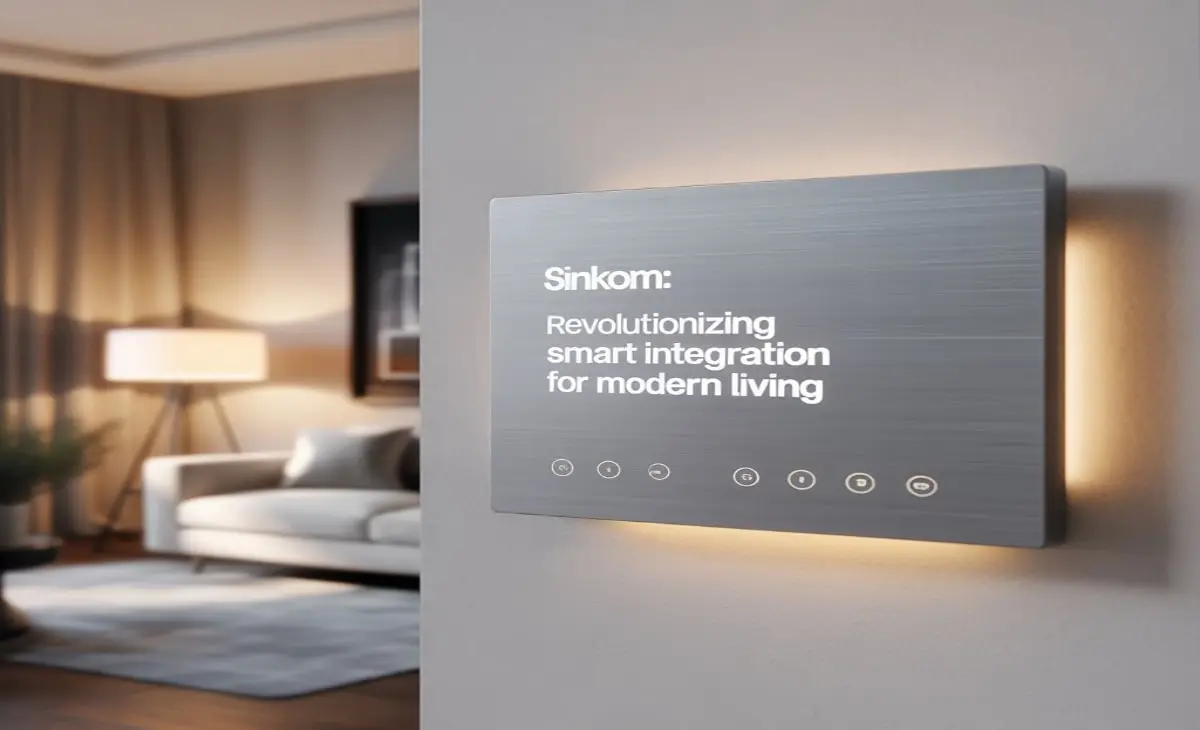Sinkom is transforming the way we think about automation, connectivity, and intelligent control systems. In a world where convenience meets innovation, the demand for smart integration platforms has skyrocketed. People are no longer satisfied with isolated technologies—they crave synchronized systems that simplify their routines and boost productivity. It excels in this particular area.
This article takes a deep dive into the Sinkom ecosystem—what it is, how it works, and why it’s emerging as a go-to solution for homeowners, industries, and developers alike. Understanding It can pave the way for a seamless digital transformation, regardless of whether you’re venturing into automation for the first time or seeking scalable integration tools.
What is Sinkom?
It is a smart integration platform that brings together different types of devices, networks, and control systems into a unified command environment. The goal is to create an interconnected ecosystem where everything from lights to industrial machinery can be monitored and managed effortlessly.
At its core, It operates as middleware that bridges communication between IoT devices, third-party applications, and user interfaces. It supports data collection, device control, and remote accessibility through its secure, scalable infrastructure. Whether applied to residential, commercial, or industrial settings, It delivers real-time intelligence and high-functioning automation.
The Mission Behind Sinkom
It is built on the belief that simplicity and smart living should be accessible. Its creators aimed to eliminate the fragmentation often seen in automation—where different devices operate under incompatible systems. By offering universal compatibility and user-friendly interfaces, Sinkom empowers people to take full control of their environments without complex programming.
Why Sinkom Matters Today
With rapid urbanization and rising energy demands, there’s an urgent need for smarter infrastructure. Consumers and corporations alike want to reduce costs, increase sustainability, and enjoy greater convenience. It enables that shift by integrating energy-saving features, predictive maintenance, and real-time monitoring—all from a centralized platform.
It’s not just a matter of technology; it’s a lifestyle enhancement. In homes, It can manage climate control, lighting, security, and more. In factories, it synchronizes production lines, enhances safety, and improves uptime. Its applications are broad, and its benefits are tangible.
Sinkom in Smart Homes
In the residential sector, It turns houses into intelligent living spaces. It supports integration with smart thermostats, cameras, lights, door locks, and voice assistants. Users can configure schedules, receive alerts, and remotely control systems via smartphones or tablets.
Imagine waking up to your blinds opening automatically, your coffee brewing, and your home temperature adjusted to your preference—all powered by Sinkom’s intuitive scenes and routines.
Industrial Applications of Sinkom
In manufacturing and production, It enhances operational efficiency. It connects machines, sensors, and analytics dashboards, giving operators full control over performance metrics. Real-time data collection helps in predictive maintenance and avoids costly downtimes.
Sinkom is particularly useful in managing utilities, HVAC systems, and safety alarms across large industrial campuses. It fosters both energy savings and operational transparency, which are critical in today’s competitive market.
The Benefits of Using It
Sinkom’s benefits are as diverse as its applications. For starters, it enhances convenience by automating repetitive tasks. It also boosts security through real-time monitoring and alert systems.
One of the standout advantages is its ability to adapt. It doesn’t rely on proprietary systems—instead, it offers compatibility with a wide range of devices and protocols. This means you don’t need to overhaul your existing tech setup to enjoy its features.
Energy efficiency is another core benefit. With smart scheduling and usage tracking, homeowners and businesses can reduce energy bills without sacrificing comfort. Furthermore, remote access ensures that users can manage their environments anytime, anywhere.
Real-World Examples of Sinkom in Action
In a mid-sized logistics firm in Malaysia, It was deployed to manage warehouse lighting, HVAC systems, and motion sensors. Within three months, energy usage declined by 18%, and maintenance costs fell due to early fault detection.
Another case involved a tech-savvy homeowner in Singapore who used Sinkom to connect their home office, kitchen, and garden. Through automation, they reduced electricity consumption while enhancing their family’s lifestyle.
The Challenges Sinkom Solves
One major challenge It addresses is system incompatibility. In a market flooded with countless devices, having a centralized controller that speaks all “languages” is critical. Sinkom bridges these gaps by supporting multiple standards, from Zigbee and Z-Wave to MQTT and Wi-Fi.
It also tackles the problem of data overload. By integrating AI-driven analytics, It filters out noise and presents only meaningful insights—making it easier for users to act on information rather than get lost in it.
How Sinkom Works: A Step-by-Step Guide
First, users install the Sinkom hub, which acts as the central controller. This device connects to all supported smart appliances and sensors either wirelessly or through wired connections.
Next, users download the Sinkom mobile or desktop app. Here, they can add devices, assign them to rooms or zones, and create automation rules. It’s drag-and-drop interface makes it easy to configure actions like turning off lights when a room is unoccupied or adjusting the thermostat based on outdoor temperature.
Once setup is complete, It continuously monitors the environment and executes tasks as defined. Its artificial intelligence algorithms gradually pick up on usage trends and recommend enhancements for improved functionality.
Customization Features in Sinkom
One of It’s strengths lies in its flexibility. Users can create “scenes” — customized sets of actions triggered by specific conditions. For example, a “Movie Night” scene could dim the lights, close the blinds, and turn on the TV.
Its geo-fencing feature can automate actions based on location. If you leave home, It can lock the doors and switch off non-essential devices. Voice control integration with Alexa, Google Assistant, and Siri adds another layer of convenience.
Compatible and Supported Devices
It supports thousands of devices across categories like lighting, HVAC, audio systems, sensors, and even irrigation controllers. It works with brands such as Philips Hue, Nest, Ecobee, Sonos, and more.
Its open API architecture also allows developers to add support for new devices and services, ensuring that Sinkom remains future-proof.
Cloud and Local Control
Unlike many platforms that rely solely on the cloud, Sinkom offers hybrid control. Critical operations can run locally even if the internet goes down, ensuring reliability in all conditions. Meanwhile, cloud services enable remote access, backups, and over-the-air updates.
Sinkom Security Measures
Security is a top priority. It uses encrypted communication channels and multi-layer authentication to prevent unauthorized access. Data is stored securely, and access logs are regularly monitored.
Moreover, users have granular control over permissions, allowing them to decide who can access which parts of the system.
Sinkom for Developers
It isn’t just for end users—it’s a playground for developers and system integrators. Its SDKs and APIs allow for deep customization and integration into broader enterprise systems.
By providing sandbox environments, code libraries, and support documentation, Sinkom encourages innovation while maintaining system integrity.
The Cost of Implementing Sinkom
Pricing depends on the complexity of your setup. Residential users can expect affordable packages starting with basic hubs and device licenses. Businesses may opt for enterprise solutions with dedicated support and analytics dashboards.
Energy savings, improved productivity, and enhanced safety quickly realize It’s ROI.
Sustainability Through Sinkom
With global emphasis on sustainability, Sinkom plays a key role in energy conservation. It tracks usage, suggests optimizations, and ensures that only necessary systems run at a given time.
In large facilities, this procedure translates into significant carbon footprint reduction, helping organizations meet their ESG goals.
Is Sinkom Worth It?
Absolutely. Whether you’re a homeowner wanting more control or a company striving for digital transformation, It delivers value on multiple fronts. Its reliability, scalability, and ease of use make it a wise investment for the future.
How to Get Started with Sinkom
Start by identifying the devices and areas you wish to control. Then choose the appropriate Sinkom hub and install the app. Most setups are plug-and-play, but professionals can help with complex configurations.
Once installed, explore the platform’s features, create your first automation, and experience the difference firsthand.
Common Misconceptions About Sinkom
Many assume It is only for tech-savvy users. In truth, its intuitive interface makes it accessible to anyone. Others express concerns about privacy, yet Sinkom effectively addresses these issues with advanced encryption and user control.
Sinkom Updates and Future Roadmap
Sinkom is constantly evolving. New updates introduce AI enhancements, voice command improvements, and device compatibility expansions. The roadmap includes support for more sustainable technologies and integrations with healthcare monitoring systems.
Sinkom
It is not just a product—it’s a paradigm shift. As our homes and workplaces become smarter, the need for a unified control system becomes essential. Sinkom answers that call by providing a platform that’s powerful yet user-friendly, broad yet customizable.
It stands at the intersection of technology, comfort, and sustainability—making it a cornerstone of future-ready living.
FAQs
What is Sinkom used for?
It is used for integrating and automating smart devices in homes, offices, and industrial spaces. It helps manage everything, from lights to security systems, on one platform.
Is Sinkom compatible with my current smart devices?
Yes, It supports a wide range of devices and protocols, including Zigbee, Z-Wave, Wi-Fi, and Bluetooth. It’s designed for universal compatibility.
Can I use Sinkom without an internet connection?
It supports local control, so core functionalities work even without the internet. However, features like remote access and cloud backups require connectivity.
How does Sinkom ensure data privacy?
It uses end-to-end encryption, secure storage, and user-level permission controls to safeguard data and prevent unauthorized access.
Is Sinkom difficult to install?
No, most It systems are plug-and-play. For more complex installations, certified professionals can assist in setup and integration.
What industries benefit most from Sinkom?
Industries like manufacturing, logistics, retail, and hospitality benefit significantly by using Sinkom to improve efficiency, safety, and energy management.
Conclusion
It is more than a tech solution—it’s a leap toward intelligent living. Whether you’re seeking comfort, efficiency, or control, this platform makes integration simple and impactful. Sinkom is ideally positioned to dominate the smart automation market thanks to its expanding device compatibility, robust security measures, and user-friendly features.
Ready to transform your space? It’s time to explore Sinkom and redefine what smart living truly means.





